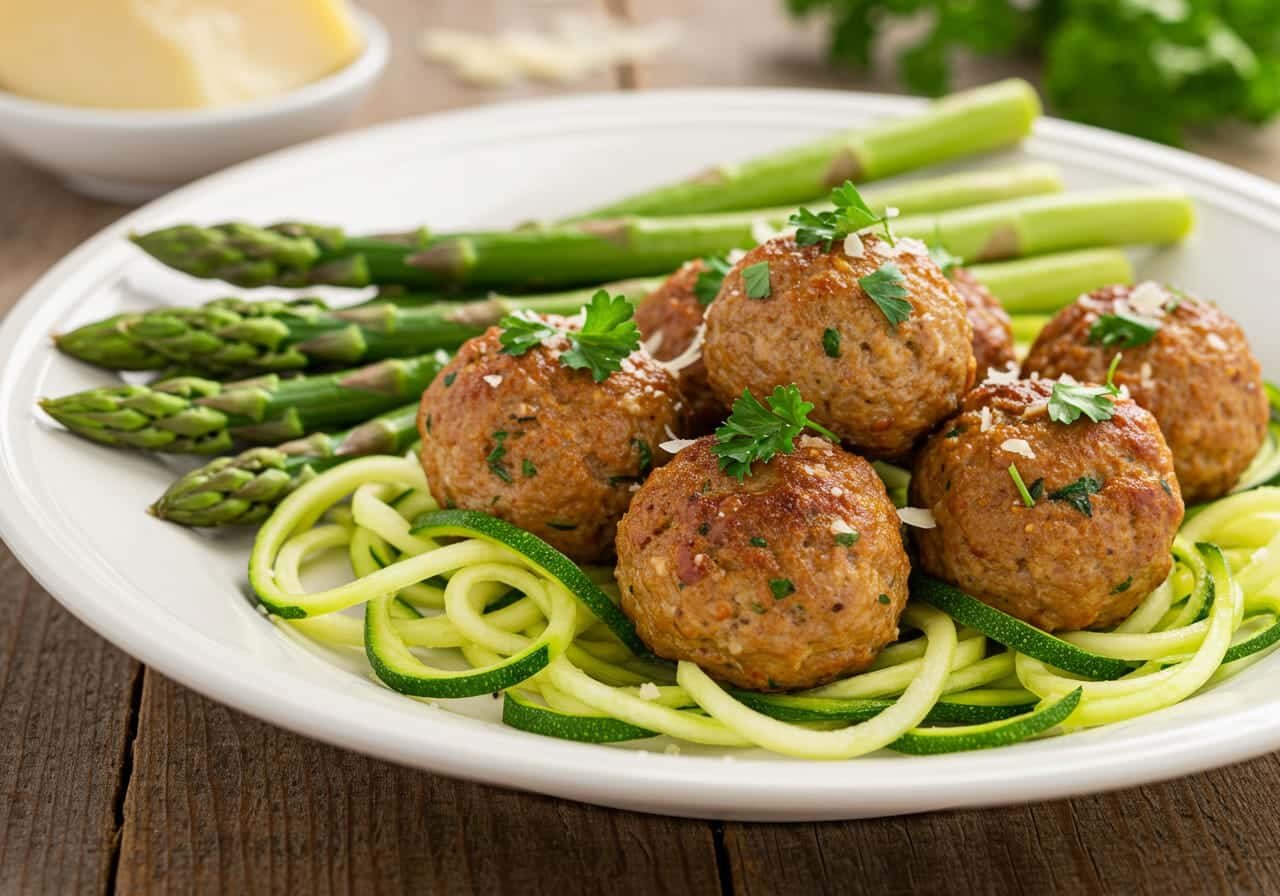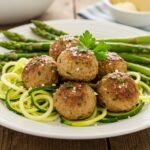Table of Contents
My name is Pedro, and I created QuickPalate to make wholesome home cooking achievable for busy Americans. After years of balancing demanding schedules with nutritious eating, I discovered that great meals don’t require complexity. Turkey meatballs with zucchini noodles perfectly embody this philosophy – they’re simple, satisfying, and packed with nutrients that nourish both body and soul. This recipe represents everything I love about accessible cooking: fresh ingredients, straightforward techniques, and flavors that make healthy eating genuinely enjoyable rather than a chore.
Always check for food allergies and dietary restrictions. Nutritional information is approximate and may vary. Please consult healthcare providers for specific dietary needs.
Why Turkey Meatballs with Zucchini Noodles Transform Your Dinner Routine
Turkey meatballs with zucchini noodles deliver exceptional nutritional value while satisfying comfort food cravings. This combination creates a complete meal that supports healthy lifestyles without sacrificing taste or convenience.
The Perfect Balance of Protein and Vegetables
Turkey meatballs provide lean protein essential for muscle maintenance and satiety. According to the USDA, ground turkey contains approximately 24 grams of protein per 84-gram serving while remaining significantly lower in fat than traditional beef options. The turkey’s rich B vitamin content, including B3, B6, and B12, supports energy production and nervous system function.
Zucchini noodles complement this protein powerhouse with impressive nutritional benefits. Research from the University of Illinois Extension shows that zucchini contains high levels of vitamin C, potassium, and fiber while providing only 19 calories per cup. The vegetable’s 95% water content promotes hydration and helps create feelings of fullness without adding excessive calories to your meal.
This protein-vegetable pairing creates what nutritionists call nutritional synergy. The combination supports sustained energy levels throughout the day while providing essential micronutrients often missing from standard American diets.
Time-Saving Benefits for Busy Americans
Turkey meatballs with zucchini noodles can be prepared in approximately 30 minutes, making them ideal for weeknight dinners. The recipe requires minimal prep work and uses simple cooking techniques that don’t demand constant attention.
The baking method for turkey meatballs eliminates the need for constant monitoring required with pan-frying. Simply form the meatballs, place them on a parchment-lined baking sheet, and let the oven work while you prepare the zucchini noodles.
Zucchini noodles cook in just 3-4 minutes, considerably faster than traditional pasta which typically requires 8-12 minutes of boiling time. This time difference becomes significant during busy evenings when every minute counts for working families.
PrintThe Best Turkey Meatballs With Zucchini Noodles in 30-Minute
Healthy 30-minute dinner featuring lean turkey meatballs served over nutritious zucchini noodles with asparagus and Parmesan cheese. Perfect for busy families seeking nutritious comfort food.
- Prep Time: PT15M
- Cook Time: PT20M
- Total Time: PT35M
- Yield: 4
- Category: Main Course
- Method: Baking
- Cuisine: American
Ingredients
1 1/4 lb ground turkey
1/3 cup onion, diced
10 cloves garlic, minced divided
1/3 cup olive oil plus 2 Tablespoons, divided
1 egg
1/3 cup panko bread crumbs
1/4 cup fresh chopped herbs (parsley, oregano, chives)
4 whole zucchini, spiralized
1 bunch asparagus
1/2 teaspoon crushed red pepper flakes
1 cup grated parmesan
Salt and pepper to taste
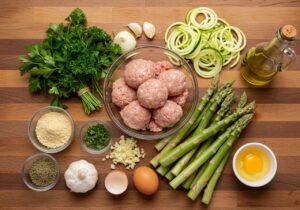
Instructions
1. Preheat the oven to 375 degrees
2. Heat 2 tablespoons of olive oil in a large skillet over medium high heat. Add onion and 2 cloves of minced garlic. Cook until onions begin to soften, about 3 minutes. Remove from heat. Cool.
3. In a large bowl combine onion mixture, ground turkey, egg, breadcrumbs, and herbs. Season generously with salt and pepper. Mix with hands until fully combined. If the mixture is too wet, add additional breadcrumbs.
4. Form mixture into 12 meatballs. Place on a baking sheet lined with parchment paper. Bake for 15-18 minutes until just cooked through. Turn oven to broil and cook an additional 3-5 minutes until golden brown.
5. Meanwhile, fill a medium saucepan with water and bring to a boil. Trim the ends from the asparagus and chop into 1-inch pieces. Add asparagus to boiling water and cook for 2 minutes. Remove pieces from boiling water (reserve water), and immediately submerge in ice water to stop the cooking.
6. Place spiraled zucchini spaghetti in a large bowl. Pour remaining boiling water over the noodles to lightly cook.
7. Heat remaining olive oil and garlic in large skillet until garlic is fragrant. Add red pepper flakes.
8. Drain zucchini spaghetti and add to skillet with garlic and olive oil. Add asparagus and parmesan cheese. Toss to coat. Serve with meatballs and garnish with fresh herbs.
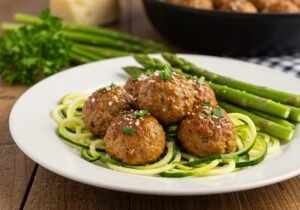
Notes
Always check for food allergies and dietary restrictions. Nutritional information is approximate and may vary. Please consult healthcare providers for specific dietary needs.
For best results, serve immediately while zucchini noodles maintain optimal texture.
Meatballs can be prepared in advance and reheated when ready to serve.
Mastering the Art of Healthy Turkey Meatballs Preparation
Creating consistently delicious turkey meatballs requires understanding proper ingredient ratios and cooking techniques. These fundamentals make the difference between dry, flavorless meatballs and juicy, satisfying ones.
Essential Ingredients for Juicy Turkey Meatballs
Ground turkey forms the foundation, but supporting ingredients prevent dryness and add flavor complexity. The egg acts as a primary binder, creating structure through protein coagulation when heated. Panko breadcrumbs absorb moisture while providing texture, with approximately one-third cup needed per pound of ground turkey.
Fresh herbs like parsley, oregano, and chives contribute aromatic compounds that make turkey meatballs genuinely flavorful rather than bland. These herbs also provide antioxidants that support overall health. Garlic adds both flavor and potential cardiovascular benefits, while onions contribute natural sweetness and additional nutrients.
The moisture-to-meat ratio remains crucial for turkey meatball success. Adding sautéed onions that have been cooled helps introduce moisture while avoiding the raw onion bite that some family members might resist. This technique also adds subtle sweetness that complements the turkey’s natural flavors.
Proper seasoning with salt and pepper enhances all other flavors present in the mixture. Salt also helps protein molecules bind together more effectively, creating better texture in the finished meatballs.
Baking vs. Frying for Maximum Nutrition
Baking turkey meatballs provides superior health benefits compared to pan-frying methods. Research indicates that baked meatballs contain significantly less fat since they don’t absorb additional cooking oil. The baking process allows natural fats to render away from the meatballs, creating a leaner final product.
Temperature control becomes easier with baking, reducing the risk of overcooking that often occurs with stovetop methods. Preheating the oven to 375°F and baking for 15-18 minutes typically produces perfectly cooked meatballs with safe internal temperatures.
The broiling step adds appealing golden color without additional fat. This technique creates visual appeal that makes the healthy choice more satisfying psychologically. Studies suggest that food appearance significantly impacts satisfaction levels, making this step worthwhile for family acceptance.
Baking also allows for larger batch preparation, supporting meal prep strategies that save time throughout the week. You can easily double or triple the recipe without additional complexity.
Creating Perfect Zucchini Noodles Every Time
Zucchini noodles require specific techniques to achieve pasta-like texture without becoming watery or mushy. Understanding these methods ensures consistent results that family members will actually enjoy eating.
Simple Spiralizing Techniques That Work
Spiralizing zucchini creates the most pasta-like appearance and texture for zucchini noodles. Choose medium-sized zucchini that feel firm when gently squeezed. Oversized zucchini often contain more seeds and water, leading to less satisfactory noodles.
Trim both ends of the zucchini before spiralizing to create clean starting and ending points. Hold the zucchini firmly while turning the handle, maintaining steady pressure for consistent noodle thickness. The goal is creating uniform strands that cook evenly.
If you don’t own a spiralizer, a vegetable peeler creates wider, fettuccine-style noodles that work equally well in this recipe. Draw the peeler along the length of the zucchini, creating long strips. This method takes more time but produces excellent results.
Alternative methods include using a julienne peeler or sharp knife to create thin strips. While these methods require more knife skills, they provide options when specialized equipment isn’t available.
Preventing Soggy Zoodles with Expert Tips
Excess moisture creates the primary challenge when preparing zucchini noodles. According to nutritional research, zucchini contains 95% water, which can create soggy results if not properly managed.
The blanching method described in this recipe works effectively for removing excess moisture while partially cooking the zucchini. Pouring boiling water over the spiralized zucchini for just 1-2 minutes softens the noodles without overcooking them.
Immediately draining the zucchini noodles after blanching prevents continued cooking that leads to mushy texture. Place the drained noodles on paper towels or clean kitchen towels to absorb remaining surface moisture.
Salt can also draw out excess water from zucchini noodles. Lightly salt the noodles and let them sit for 10-15 minutes, then pat dry with paper towels. This technique works particularly well when preparing noodles in advance.
Serving zucchini noodles immediately after preparation maintains optimal texture. Unlike traditional pasta, zucchini noodles don’t hold well and should be consumed shortly after cooking for best results.
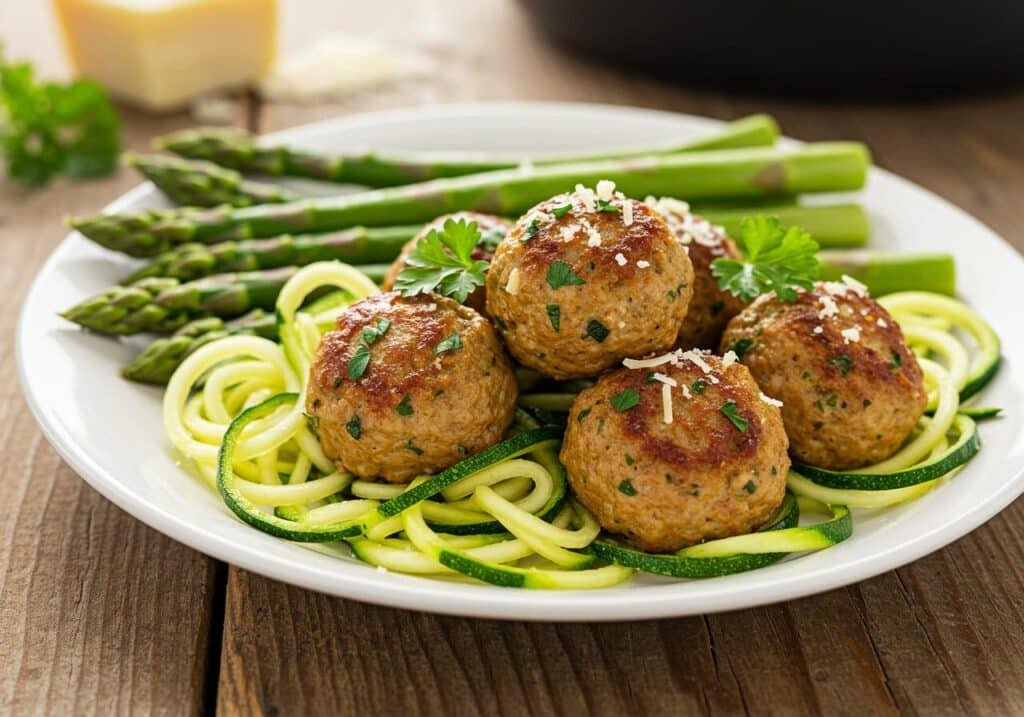
Complete Recipe and Nutritional Benefits
This turkey meatballs with zucchini noodles recipe provides complete nutrition information and step-by-step instructions for consistent success. Understanding both preparation methods and health benefits helps home cooks make informed decisions.
Step-by-Step Cooking Instructions
Prep Time: 15 minutes | Cook Time: 20 minutes | Servings: 4 | Difficulty: Easy
For the Meatballs:
- 1 1/4 lb ground turkey
- 1/3 cup diced onion
- 10 cloves garlic, minced (divided)
- 1 egg
- 1/3 cup panko breadcrumbs
- 1/4 cup fresh herbs (parsley, oregano, chives)
- Salt and pepper to taste
For the Zucchini Noodles:
- 4 whole zucchini, spiralized
- 1 bunch asparagus, chopped
- 1/3 cup olive oil (divided)
- 1/2 teaspoon red pepper flakes
- 1 cup grated Parmesan cheese
Preheat oven to 375°F. Sauté onion and 2 garlic cloves in 2 tablespoons olive oil until softened. Cool completely. Combine turkey, onion mixture, egg, breadcrumbs, and herbs. Form into 12 meatballs and bake 15-18 minutes. Broil 3-5 minutes until golden.
Meanwhile, blanch asparagus for 2 minutes, then shock in ice water. Pour boiling water over spiralized zucchini to lightly cook, then drain thoroughly.
Health Benefits and Nutritional Information
This turkey meatballs with zucchini noodles recipe provides approximately 391 calories per serving with exceptional nutritional balance. The macronutrient breakdown includes 35% protein, 28% fat, and 37% carbohydrates, creating sustained energy without blood sugar spikes.
According to Harvard Health Publishing, the high protein content supports muscle maintenance and promotes feelings of fullness that can aid weight management efforts. The lean turkey provides all essential amino acids needed for optimal body function.
The zucchini noodles contribute significant vitamin C, providing approximately 139% of daily needs per serving. This vitamin C content supports immune function and helps with iron absorption from the turkey. The potassium content helps regulate blood pressure and supports heart health.
The dish provides 47% of daily fiber needs, supporting digestive health and promoting beneficial gut bacteria. According to the Mayo Clinic, adequate fiber intake helps lower cholesterol levels and supports healthy weight maintenance.
The combination creates a nutrient-dense meal that supports multiple health goals simultaneously: weight management, heart health, and sustained energy levels throughout the day.
| Nutritional Component | Per Serving | % Daily Value |
|---|---|---|
| Calories | 391 | 20% |
| Protein | 37g | 74% |
| Total Fat | 13g | 17% |
| Carbohydrates | 40g | 14% |
| Fiber | 13g | 47% |
Frequently Asked Questions
Are turkey meatballs actually healthy?
Yes, turkey meatballs are significantly healthier than traditional beef versions. According to the USDA, turkey contains 24 grams of protein per serving while being lower in saturated fat than beef. Turkey provides essential B vitamins, selenium, and zinc while supporting muscle maintenance and heart health. When baked rather than fried, turkey meatballs become even healthier by reducing added fats.
Are zucchini noodles healthy for you?
Zucchini noodles are exceptionally healthy, containing only 19 calories per cup while providing vitamin C, potassium, and fiber. Research from nutrition experts shows that zucchini’s 95% water content promotes hydration and feelings of fullness without adding significant calories. They’re naturally gluten-free, low-carb, and suitable for various dietary approaches including keto and paleo eating plans.
What is the healthiest way to cook turkey meatballs?
Baking is the healthiest cooking method for meatballs. Studies indicate that baked meatballs contain up to 50% less fat than pan-fried versions since they don’t absorb additional cooking oil. Baking at 375°F allows natural fats to render away while ensuring safe internal temperatures. The method also provides better texture control and easier preparation for larger batches.
Can you add zucchini to meatballs?
Yes, grated zucchini can be added directly to turkey meatball mixture to increase moisture and nutritional content. The zucchini should be grated finely and excess moisture removed by salting and draining for 15 minutes before mixing. This technique adds fiber, vitamins, and helps prevent dry texture that sometimes occurs with lean ground turkey.
Sources
- University of Illinois Extension – Zucchini noodles nutritional benefits
- USDA Nutrient Database – Turkey nutrition information
- Harvard Health Publishing – Protein benefits and requirements
- Mayo Clinic – Fiber and digestive health benefits
- BBC Good Food – Turkey health benefits and B vitamins
- Healthline – Complete turkey nutrition profile
- American Heart Association – Healthy cooking methods and fat reduction
Conclusion
Turkey meatballs with zucchini noodles represent the perfect balance of nutrition, convenience, and satisfaction that modern families need. This recipe transforms simple ingredients into a restaurant-quality meal that supports healthy living goals while delivering genuine comfort food satisfaction. The combination of lean protein, fresh vegetables, and aromatic herbs creates flavors that make nutritious eating feel like a treat rather than a sacrifice. Whether you’re meal prepping for the week or creating a special weeknight dinner, this dish proves that healthy cooking can be both simple and delicious.
